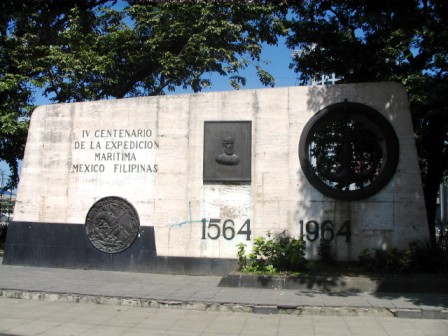|
27 November - 3 December 2007
We
left Ottawa on November 19, 2007 to travel
to the Philippines
for three months of travel and work. December
was our month to
volunteer with the Center for Education, Research and Volunteering
Philippines (CERV) a small NGO affiliated with Global Volunteer Network
(GVN), an umbrella organization run out of New Zealand with projects all over
the world. When we left our project in January we
had another two months to explore the
Philippines. That is the main thrust of
our travels this year, sandwiched between visits to Paris,
France
at the beginning and end of our trip. This isn't the most direct way to
get to the
Philippines
but our daughter Erica moved to Paris at the beginning of October with
her husband Andrew Auerbach and their two small boys, Atticus, almost
three and Roman, now 11 months. Our account of our time in France is on another website page,
this account is of our travels and experiences in the Philippines.
We flew
from Paris to
Manila on Finnair
via Helsinki and
Hong Kong. We left our daughter’s apartment in
Paris at 8 AM Monday morning November 26 and arrived in
Manila
the next day November 27 at 1 PM.
Manila
is 7 hours ahead of
Paris and 13 hours
different from
Ottawa, so we
were suffering from jet lag again. We were very glad to be met by
Raymund Villanueva, the CERV manager in
Manila. He drove us to our hotel in Malate, the
downtown tourist area of Manila where we would spend
the next three days before transferring to the CERV headquarters for our
pre-assignment training.
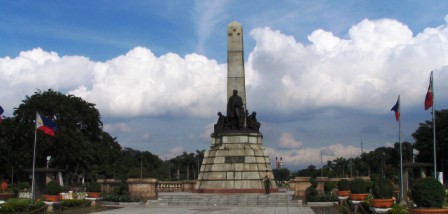 Manila
is a typical third world city with a population of 11 million. The
traffic jams are continuous, the smog is ever present and the poverty is
in your face. Otherwise, the people are friendly and helpful and we
enjoyed our visit but a few days at a time are enough. It was a 40
minute walk from our hotel to Intramuros, a walled city founded in 1571
by Miguel Lopez de Legazpi at the mouth of the Pasig
River. It withstood attacks by Chinese
pirates, Dutch forces, and occupation by British, American and Japanese
forces but was finally destroyed by US bombing during the Battle of
Manila at the end of WWII. It has been extensively rebuilt and is both a
thriving community and a popular tourist attraction.
We visited San
Agustin Church, the only building left intact after the bombing. The
interior of the church was being set up for a choral music festival
starting that night that we didn’t attend, unfortunately. The adjoining
museum was more extensive and interesting than we had expected. We spent
several hours learning about the history of
Manila
especially related to the various religious orders. Manila
is a typical third world city with a population of 11 million. The
traffic jams are continuous, the smog is ever present and the poverty is
in your face. Otherwise, the people are friendly and helpful and we
enjoyed our visit but a few days at a time are enough. It was a 40
minute walk from our hotel to Intramuros, a walled city founded in 1571
by Miguel Lopez de Legazpi at the mouth of the Pasig
River. It withstood attacks by Chinese
pirates, Dutch forces, and occupation by British, American and Japanese
forces but was finally destroyed by US bombing during the Battle of
Manila at the end of WWII. It has been extensively rebuilt and is both a
thriving community and a popular tourist attraction.
We visited San
Agustin Church, the only building left intact after the bombing. The
interior of the church was being set up for a choral music festival
starting that night that we didn’t attend, unfortunately. The adjoining
museum was more extensive and interesting than we had expected. We spent
several hours learning about the history of
Manila
especially related to the various religious orders.
We
continued on to
Fort
Santiago
guarding the entrance of the
Pasig
River. We walked on top of
a small section of the walls surrounding the whole area to get the view
of the river and surrounding city. Gardens lead to the remains of
dungeons where hundreds of Filipinos and Americans died during the
occupation of Manila by the Japanese
during WWII. There is a museum dedicated to Dr Jose Rizal, a revered
poet, executed in 1896 for inciting revolution against the Spanish
occupiers. In fact the entire fort is a memorial to all Filipinos who
have died for the cause of freedom.
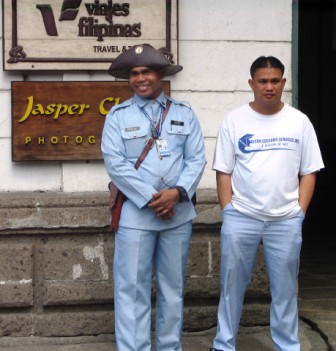 As
part of our orientation, we returned with Raymund Villanueva the next
Sunday to visit Casa Rosa,
a restored collection of nine houses built
around inner courtyards for the extended family of one of the Spanish
gentry. A visit with Raymund to the
National
Museum
of the Filipino People extended our knowledge of the people and cultures
of the
Philippines. As
part of our orientation, we returned with Raymund Villanueva the next
Sunday to visit Casa Rosa,
a restored collection of nine houses built
around inner courtyards for the extended family of one of the Spanish
gentry. A visit with Raymund to the
National
Museum
of the Filipino People extended our knowledge of the people and cultures
of the
Philippines.
Shopping
seems to be the national pastime in
Manila, especially in one of the new mega malls.
Customers lined up to be first in at opening time in the morning and
stayed to purchase and eat in the food courts all day long. The only
disconcerting aspect was the security check at the entrances. Guards
checked purses and bags before allowing customers through the door.
Manila
does not want a repeat of a Mall bombing that occurred last October.
There was one near us, anchored by the giant
Robinsons
Department and Grocery
Stores. We visited to purchase water and other items we had neglected to
buy at home. Unlike our stores, there was no shortage of sales
personnel. There was at least ten times the number of helpful and
friendly staff to serve us that we encounter at home.
After
having dinner and attending a performance of traditional dancing at a
local restaurant, Ray and I returned to our hotel to receive a note from
Raymund Villanueva telling us there had been an attempted coup that day
and there would be a curfew from
midnight to
5 AM. That was the first we
had heard of any trouble. We watched the news on TV that night and the
next morning, then got a first hand report from Raymund. He has three
jobs, one is manager of the CERV project and another is with the media
for a small community newspaper. The current government of the Philippines has a reputation for
being corrupt and the people have openly called for the resignation of
President Gloria Macapagal Arroya (popularly known as GMA). There had
been rumours that something was to happen during the trial of two men
involved in a similar coup attempt in 2005. All the media, including
Raymund, were at the courthouse to witness the two accused walk out of
the courthouse and take over the luxury Peninsula Hotel. We were not
staying at this hotel. It was way above our meager budget and in another
part of the city. Raymund luckily had just left the hotel to return to
his vehicle when the military stormed the hotel. He claimed he had a
better view of the proceeding from outside than those journalists who
were still inside hiding from the bullets. Raymund told us that the
biggest error the coup organizers made was not ensuring that they had
public support for the coup. Besides, the population were not thrilled
at the prospect of a military takeover.
We
took a taxi the day after the coup attempt to the CERV headquarters in
Quezon City, a suburb north
of the city. The almost one hour trip in heavy traffic passed by the
worst squatter’s slums we have seen in any city we have ever visited.
The roads were bordered by endless rows of flimsy huts. The city
periodically bulldoze the buildings away from the road but the people
just return to build again. The alternative is land far away from the
city with no schools or facilities. Children play next to the road and
their parents shop in the makeshift stores set up next to the shanties.
Life goes on.
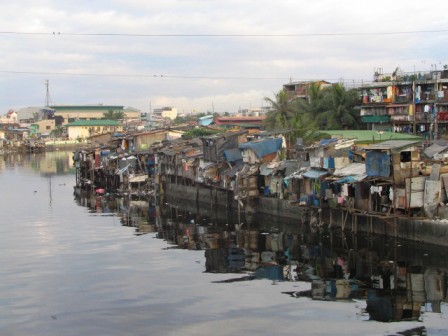 As
part of a city tour the next Sunday we went past the infamous Smoke
Mountain,
named for the ever-smoldering remains of a mountain of garbage. Several
years ago the mountain collapsed killing hundreds of residents who make
their living combing through the refuse for anything of value. The city
closed this dump site and greenery partially covers the mountain but a
large community still lives there eking out a living. As
part of a city tour the next Sunday we went past the infamous Smoke
Mountain,
named for the ever-smoldering remains of a mountain of garbage. Several
years ago the mountain collapsed killing hundreds of residents who make
their living combing through the refuse for anything of value. The city
closed this dump site and greenery partially covers the mountain but a
large community still lives there eking out a living.
CERV
chooses to operate from
Quezon
City
because of the lower rents and quieter atmosphere. They managed to rent
a large house that is still badly in need of repair as after 2 ˝ years
of operation. CERV operates on a shoestring, and often finds they must
make up the deficit themselves. Nevertheless, they believe in their
mission to help the Filipino people and work on strengthening their
projects in Quezon City and on the
Island
of Tablas, in the
Romblon group of islands, where we are posted. There are three projects
on Tablas where volunteers are currently employed for one to
six months. A volunteer doctor works in a clinic in San Agustin, there
is an Environment project to grow and replant mangroves in a fish
sanctuary in Carmen, a small barangay (community) about 4 km north of
San Agustin, and a School Maintenance project where an elementary school
is being painted in Sugod, another 3 km farther north.
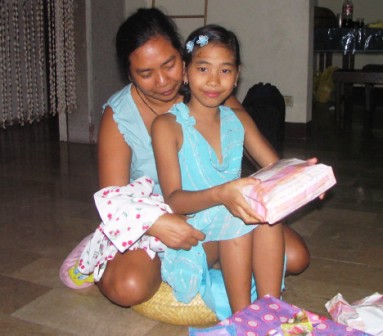 Our
visit to the CERV house in
Quezon City
started out with a celebration. Andrea, the daughter of Eden Navia, the
Tablas
Island
coordinator, turned nine.
Several Aunts, Uncles, Cousins and friends
were on hand for her birthday. Andrea was dressed in her party clothes
for the occasion. Dinner consisted of all Andrea’s favourite foods,
canapés of marshmallow, hotdog pieces and cheese, fried chicken,
spaghetti with tomato sauce and sliced hot dogs, all washed down with
Coke. Dessert was a big chocolate cake decorated with icing flowers and
inscribed to Andrea. After dinner Andrea opened her presents, the
favourites being a new denim dress and a Barbie rolling school bag.
Little girls are the same everywhere. Our
visit to the CERV house in
Quezon City
started out with a celebration. Andrea, the daughter of Eden Navia, the
Tablas
Island
coordinator, turned nine.
Several Aunts, Uncles, Cousins and friends
were on hand for her birthday. Andrea was dressed in her party clothes
for the occasion. Dinner consisted of all Andrea’s favourite foods,
canapés of marshmallow, hotdog pieces and cheese, fried chicken,
spaghetti with tomato sauce and sliced hot dogs, all washed down with
Coke. Dessert was a big chocolate cake decorated with icing flowers and
inscribed to Andrea. After dinner Andrea opened her presents, the
favourites being a new denim dress and a Barbie rolling school bag.
Little girls are the same everywhere.
Saturday morning Ray and I were joined by a third new volunteer, Carly
Bannon from Melbourne Australia. We spent a long and
informative day going through the history and cultural idiosyncrasies of
the Philippines and
learning a bit of the Filipino language. English is the second language
of the Philippines,
but a few words in Filipino do help to break the ice. This project is a
family affair. Our lessons were given by Raymund, his wife Pom and Eden,
Pom’s sister. The
Philippines
project was inspired by a GVN affiliate, an Orphanage in Nepal where another sister works. We
learned more about the Environment project from Jeremy and Ben, two
New Zealand fellows who just finished six weeks
on Tablas while we were at CERV
headquarters.
|
